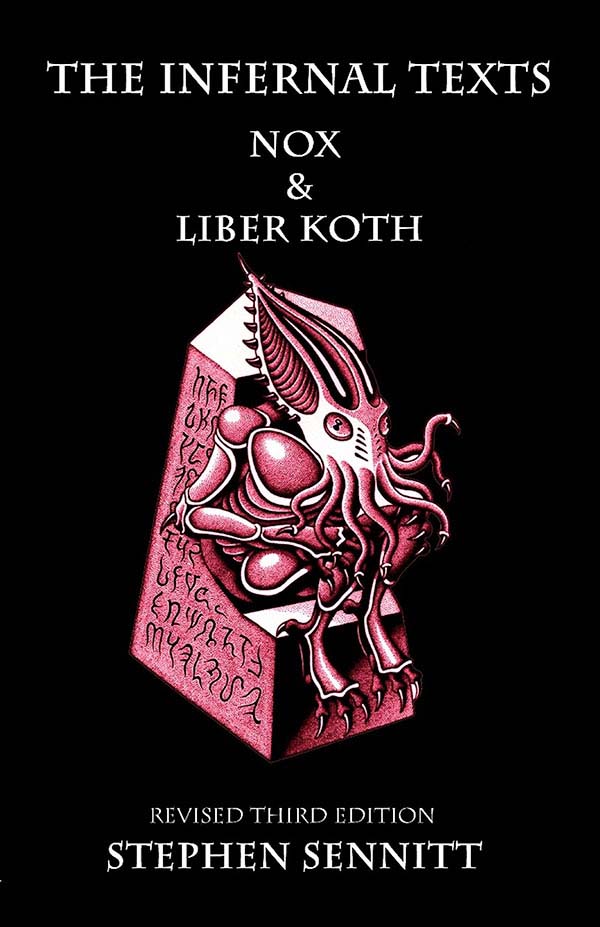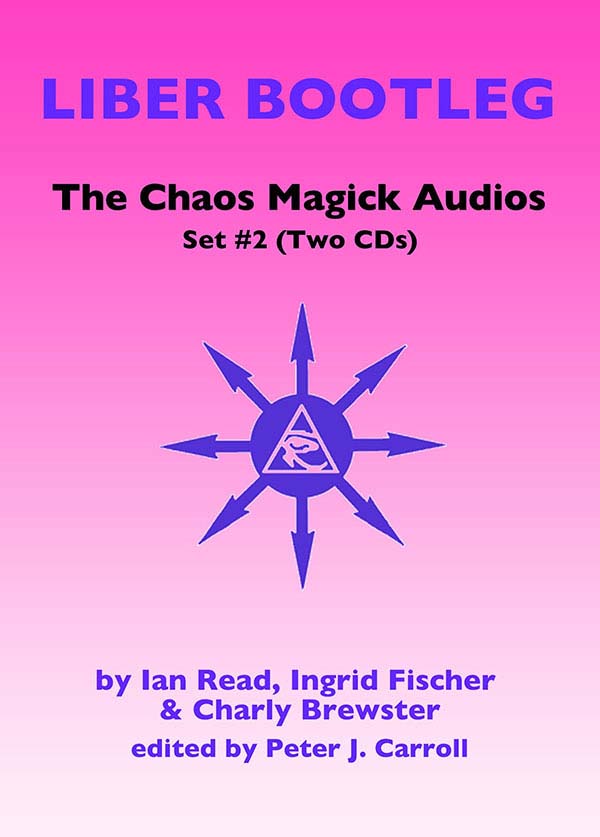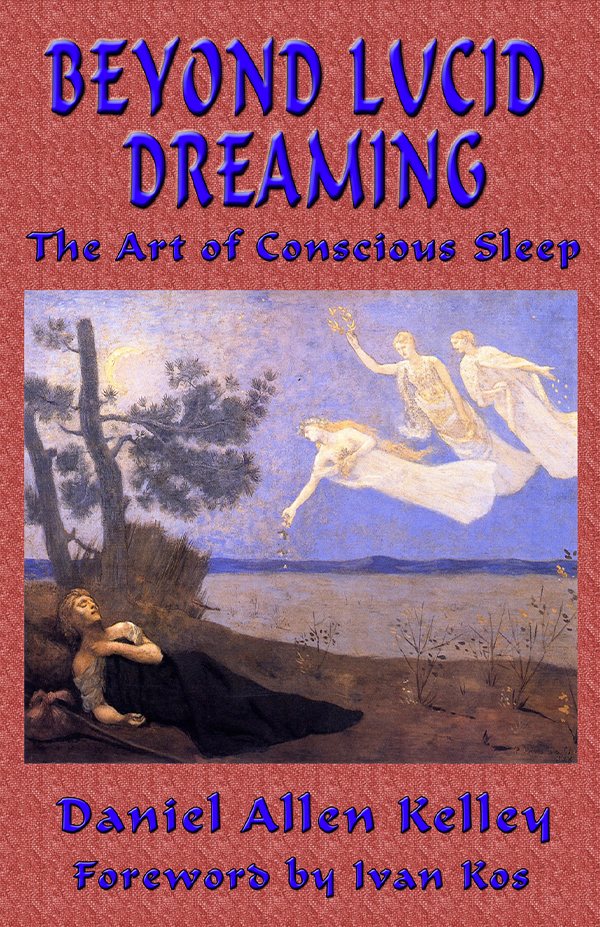Introduction to Liber Koth: Shadowing Forth
Part of the continuing problem which plagues magick is the tendency to supersede old values which smack of literalism only to replace them with psychological interpretations. Though psychology and personal psychoanalysis is useful and perhaps desirable, it is again only a paradigm, and it is a mistake to use it to explain away the mysteries of the universe in the vain belief that because the mind struggles to understand these mysteries it must be somehow, in all cases, inventing them. Like all perceptions, magickal experiences are filtered through, and coloured by, the human mind; how could it be otherwise? Magick as Applied Psychology has its place, but it is the beginning, not the end, of the long road to illumination.
There is a drawing by Austin Osman Spare entitled "Emanations of the Ego" which is rife with his curious and idiosyncratic symbology depicting the Centaur, an atavism, encountering strange winged beings formed from satyr-like faces which are frozen into masks of ecstasy. This is the transcendent self---the Quantum Reality self---with its lucid awareness of self-permutation; the transformation of consciousness through willed desire.
Spare's non-reliance on the traditional arcana of occultism, and his occasional borrowing from more obscure traditional sources, allowed him to formulate a highly personal, extremely powerful, approach to magick which is only now beginning to influence a wider contingent of modern practitioners. Spare was so far ahead of his time in his approach to magick that even now he is for the most part reviled and misunderstood. In reality, Spare understood the human mind's inability to directly comprehend reality, recognising that transcendent experiences could be reduced to meaninglessness not so much by the Golden Dawn-like tendency to overuse ready-made conceptual structures, but by the still prevalent tendency to interpret such experiences in the light of prosaic morality. As Quantum discoveries suggest, reality does not conform to mundane expectations akin to morality or "good sense", and it was in anticipating this view that Spare denounced all limits in an attempt to comprehend the incomprehensible. Like Crowley, his more conventional peer, Spare showed that the way forward meant totally abandoning the stifling morality and religious accretions which had attached themselves to occultism. His sinister reputation rested on the fact that he was true to himself and would accept no restrictions conferred by society's transient values; nor was he willing to respect the occult fraternity's sense of masonic decorum. He would not use belief to hold back reality. When you are serious about reality there can be no holding back.
That the question of prosaic morality and the gimcrack considerations of "white" and "black" magick should still seriously enter into the field of modern occultism is absurd. Only those people who are incapable of facing reality need to hold it back with blinkered beliefs about the immorality of "black" magick. Such warnings smack of repressed desire, and reveal a twisted psychology which mistrusts itself so completely that it automatically condemns others who claim to use such power with impunity, unable to accept there can be such purity of intention. These latter-day primitives also condemn sex and other natural pleasures, believing such functioning to be beneath their conception of the "spiritual" and therefore not worthy of consideration. If it is the task of the Great Work to become "whole," to comprehend all the facets of Self, to form the most perfect possible equation, how can anything be left out? How can we comprehend reality with so many puerile moral restrictions? Spare demonstrated that absolutely everything in the self's domain was intrinsic to understanding reality. Crowley echoed this when he announced: "The only sin is restriction."
The recently developed occult paradigm based on H.P. Lovecraft's weird fictional cosmology (known popularly as the Cthulhu Mythos) is a dynamic example of the type of "black" model which can expand the boundaries of perception, though it can produce an opposing effect of peculiarly claustrophobic terror. It is this dual-edge which makes it so interesting!
That an intrinsically "fictional" mythos can be utilised with such magickal expediency is a surprising fact to some sceptics. The point to remember is that even accepted "facts" have no other purpose than to model reality. It is therefore obvious that accepted "fiction" can also model reality if it is understood that, like all human-created paradigms, these things have no ultimate meaning in themselves. Taking a "fictional" world on board with all its trappings, with the aim of investing belief in it as a substitute for the "factual" world around us (the failing of so many occultists and almost all religious folk) is escapism at its worst. Such a tendency toward blind faith shows appalling ignorance in the light of current scientific and magickal discoveries.
With this in mind, we can understand how "fictional" models such as the Cthulhu Mythos can be used to broaden our perception of reality if they are utilised as a symbolic language, a way of mediating the very real energies which they represent. Only a died-in-the-wool occult traditionalist would argue that a "fictional" entity like Azathoth was somehow less "real" than, say, the High Priestess of the Tarot. The level of unsophistication in such a view is breathtaking! The question is not one of the ultimate reality of a particular equation after all, but what the equation is meant to represent. Both the "Azathoth" and the "High Priestess" equations predict the existence of something beyond the human mind to perceive directly. If correctly invoked, both register as a particular experience which expands the sense of self, enabling us to change ourselves and things around us, bringing us that much closer to reality.
The Lovecraftian Cthulhu Mythos entities are masks of chaos, abstractions indicating that the mind which conceived of them was struggling to form equations which would describe the experiences he was undergoing. Lovecraft's dreams were haunted by cosmic scenarios he found personally difficult to relate to: so much so that unlike Blavatsky, Von Liebenfels, and many other cosmological literalists, he presented his ideas in fictional form---this was in the realisation that although his conceptions had a strange validity for the times in which he lived (in fact, Lovecraft, like Spare, was ahead of his time in this instance) they were not acceptable as "realities" to his rational, sceptical mind. It is a demonstration of Lovecraft's superior intellect and mental strength that, unlike so many others, he could resist investing belief in his powerful conceptions without necessarily compromising their validity in philosophical and theoretical terms. This is a form of mental discipline which works well in conjunction with modern magickal praxis, and although it is doubtful Lovecraft would have approved, it is a discipline which can transform his nightmarish concepts into a coherent working system of magick, an extreme paradigm for extreme gnosis.
Freely interpreted, the Cthulhu Mythos is an especially useful magickal equation in that it strives to go beyond anthropocentricism, pushing back the conceptual limits which we place on reality. The masks of self which shadow-forth are strange, unfamiliar ones, and yet paradoxically there is something about them which we still recognise.
In an era of weak-willed conformity and blind-faith, still rife in even the most "advanced" fields of human inquiry, this is a paradigm through which we can learn more about reality. It offers enticing danger, cathartic power and a promise of transcendence.
These primal entities of the mythos pantheon are Beyond Good and Evil; they represent the self free of the "Sin of Restriction", mighty and unafraid.
Let us invoke Them, ourselves free of restriction, mighty and unafraid, with the cry: "Now For Reality!"









